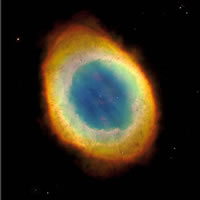When will our star explode in a supernova?
1 Answer
Astronomers do not expect the sun to end its life as a supernova, however, in about 4-5 billion years, they expect the sun to expand into a planetary nebula.
Explanation:
Typically a supernova occurs when fusion in the center of a star can no longer provide enough outward pressure to balance out gravity. Fusion requires a large input of energy in order to bring protons close enough for the strong force to overcome electrostatic repulsion. Once fusion occurs, mass is converted into energy which creates an outward pressure on the star.
Since larger elements have more protons, they require more energy to overcome repulsion. It turns out that there is a critical mass where the amount of energy returned from fusion is less than the amount of energy put into fusion. Once a star begins fusing iron nuclei, the output energy of fusion can no longer support the star, and it rapidly begins to collapse.
 )
)
As the star collapses, fusion continues at an increasing rate, creating a buildup of neutrinos. Eventually, the shock wave of escaping neutrinos blows the star apart in a supernova. Since the sun does not have enough mass to generate the pressure required for iron fusion, the sun cannot reach the supernova phase without intervention by another star.
Its expected in about 5 billion years however, the outer layers of the sun will heat up and expand out into space creating a planetary nebula. A planetary nebula is more of a gradual expansion than an explosion, and the core is left as an electron degenerate white dwarf.

If the sun were part of a binary system, the other star could dump enough mass onto the white dwarf sun to restart fusion. Since a white dwarf does not expand and cool like regular stars, the fusion becomes a runaway process blowing the star apart. This is a supernova type 1a, and it is not expected to happen to our sun.

